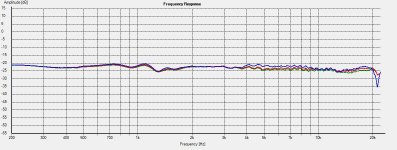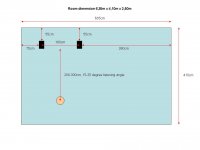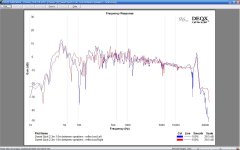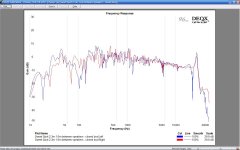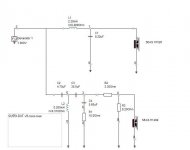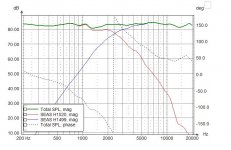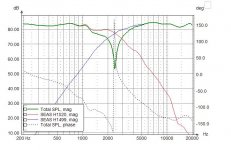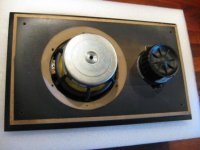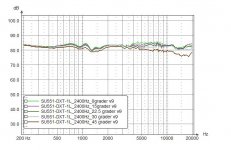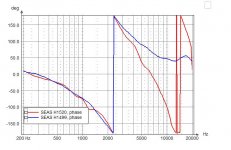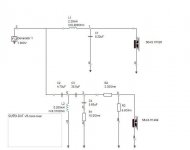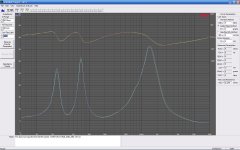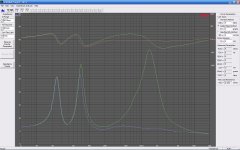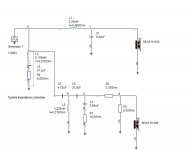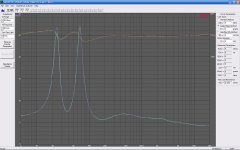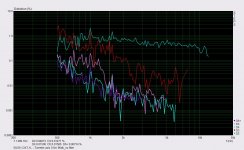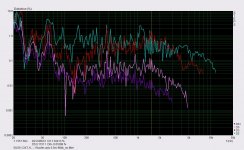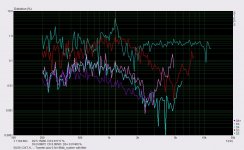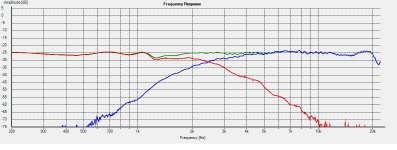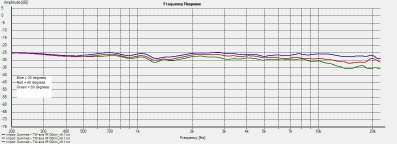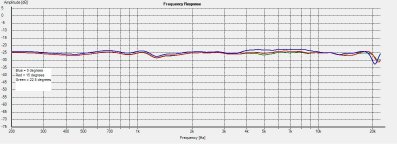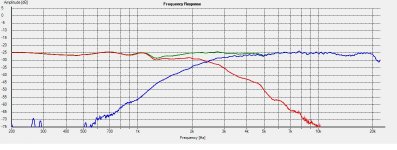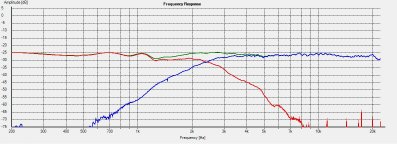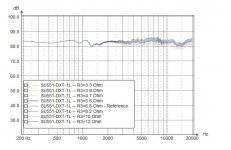Ok, I cannot really say that it’s missing transparency, but it’s less transparent than the SAL451 which has a smaller woofer with aluminium as cone material. Perhaps might the lower cross-over frequency of the SAL451 also play a part of it. I find the DXT to be more neutral than the SEAS H1212 which has a bit more sparkle and sibilance than the DXT. This could also be the tuned tonal balance between them. The DXT seems to require some serious break-in before they shine. I have now given them about 25 hours of break-in and I think they are beginning to loosen up and “sparkle a bit more for each hour I give them.🙂
Hello Goran,
Regarding your next project, how about something a bit different? You seem to have mastered the art of designing a two-way speaker so how about a 3-way? Perhaps a 10" + 4" + tweeter or even a smaller 8" + 2" mid dome + tweeter? Morel make a nice 2" dome tweeter; MDM-55 or any 3" cone drivers such as the Scan-Speak 10F, which seems to be getting a lot of print yet no completed designs.
Regarding your next project, how about something a bit different? You seem to have mastered the art of designing a two-way speaker so how about a 3-way? Perhaps a 10" + 4" + tweeter or even a smaller 8" + 2" mid dome + tweeter? Morel make a nice 2" dome tweeter; MDM-55 or any 3" cone drivers such as the Scan-Speak 10F, which seems to be getting a lot of print yet no completed designs.
Hello Ultrakaz,
Unfortunately I have a wife that doesn’t share my interest in speaker building 🙁 I actually have box ready for an all-active 3-way with a side-mounted 12” and dual 5” in a MTM configuration, but haven’t been able to convince her to place them in the living room, since they are to big.
The Scan-Speak 10F has for a long time now caught my interest, likewise the Dayton RS52 dome midrange. I might perhaps get away with a very small 3-way e.g. a 7-8” bass capable woofer a 3” mid or 2” dome mid and a suitable tweeter. Any suggestions on a 7-8” that fits in a 25-28 liter box, like the “Parts-Express 302-751s”? I’m thinking of buying this box for another MTM project and perhaps I can reuse it for a small 3-way.
/Goran
Unfortunately I have a wife that doesn’t share my interest in speaker building 🙁 I actually have box ready for an all-active 3-way with a side-mounted 12” and dual 5” in a MTM configuration, but haven’t been able to convince her to place them in the living room, since they are to big.
The Scan-Speak 10F has for a long time now caught my interest, likewise the Dayton RS52 dome midrange. I might perhaps get away with a very small 3-way e.g. a 7-8” bass capable woofer a 3” mid or 2” dome mid and a suitable tweeter. Any suggestions on a 7-8” that fits in a 25-28 liter box, like the “Parts-Express 302-751s”? I’m thinking of buying this box for another MTM project and perhaps I can reuse it for a small 3-way.
/Goran
I see, that the cabinet has a 9" inch front baffle which eliminates 10" woofers 🙁 But, the Seas A26re4 sure looks easy to work with.
For some reason the 8" appears to be the odd man out when you consider the offerings. There are a lot more 7" and 6.5" to choose from. Then you can consider if two 5" or 5.5" are better than a single 7"(?) in a 1 cubic foot box.
How about a SU551 MTM with DXT tweeter crossed as low as possible? Aside from increasing efficiency, this will lighten the load on the woofers, decrease distortion and hopefully increase transparency.
Or use the ER18RNX for a mini 3-way with the 10F or RS52 (though it appears that the Morel MDM55 is more favored and has an easier response curve to work with), crossed high to a .75" dome tweeter.
For some reason the 8" appears to be the odd man out when you consider the offerings. There are a lot more 7" and 6.5" to choose from. Then you can consider if two 5" or 5.5" are better than a single 7"(?) in a 1 cubic foot box.
How about a SU551 MTM with DXT tweeter crossed as low as possible? Aside from increasing efficiency, this will lighten the load on the woofers, decrease distortion and hopefully increase transparency.
Or use the ER18RNX for a mini 3-way with the 10F or RS52 (though it appears that the Morel MDM55 is more favored and has an easier response curve to work with), crossed high to a .75" dome tweeter.
Hello Ultrakaz,
Thanks for your design suggestions. Now my head starts spinning with ideas. 😀
I like the idea with the ER18RNX as the woofer and perhaps the new SEAS 0.75” 22TFF (H1280) as the tweeter and some cone/dome midrange.
Here are three different design suggestions:
1. SEAS ER18RNX (H1456) + SS 10F + SEAS 22TFF (H1280) (7” + 3” + 0.75”)
2. SEAS ER18RNX (H1456) + Dayton RS52 + SEAS 22TAF/G (H1283) (7” + 2” + 0.75”)
3. SEAS ER18RNX (H1456) + Morel MDM55 + SEAS 22TFF (H1280) (7” + 2” + 0.75”)
Many people would argue that this is not a real 3-way since the woofer is so small, but I really like the idea and I think this design might fill a gap where there aren’t many similar designs made. It would be pretty easy to build such a box with a high WAF factor. 😛
Ok, a 7” woofer can only play a limited bass, but isn’t really optimal to play midrange either so it’s a compromise either way. This design wouldn’t be choice for bass-oholics and SPL junkies, but here we would have a chance to focus on the midrange and a system in a small package.
Next I’m going to build my own version of the SR71 in a larger box and the ER18RNX hopefully blooms out in that box. Then I will decide if it will work in a small 3-way.
/Goran
Thanks for your design suggestions. Now my head starts spinning with ideas. 😀
I like the idea with the ER18RNX as the woofer and perhaps the new SEAS 0.75” 22TFF (H1280) as the tweeter and some cone/dome midrange.
Here are three different design suggestions:
1. SEAS ER18RNX (H1456) + SS 10F + SEAS 22TFF (H1280) (7” + 3” + 0.75”)
2. SEAS ER18RNX (H1456) + Dayton RS52 + SEAS 22TAF/G (H1283) (7” + 2” + 0.75”)
3. SEAS ER18RNX (H1456) + Morel MDM55 + SEAS 22TFF (H1280) (7” + 2” + 0.75”)
Many people would argue that this is not a real 3-way since the woofer is so small, but I really like the idea and I think this design might fill a gap where there aren’t many similar designs made. It would be pretty easy to build such a box with a high WAF factor. 😛
Ok, a 7” woofer can only play a limited bass, but isn’t really optimal to play midrange either so it’s a compromise either way. This design wouldn’t be choice for bass-oholics and SPL junkies, but here we would have a chance to focus on the midrange and a system in a small package.
Next I’m going to build my own version of the SR71 in a larger box and the ER18RNX hopefully blooms out in that box. Then I will decide if it will work in a small 3-way.
/Goran
Hello Goran,
My suggestions are practical ones. I'm one of many people with a 300b SET valve amplifier. The pursuit of the best possible sound tends to lead there in the end for many of us. So we have max 8 watts available. Assume we have a small-medium room since otherwise we'd have big ss amps. Assume the kind of music lovers who listen to a mixture of classical, jazz, world/folk, vocals and modern rock at reasonable "critical listening" levels.
The goal would be enough sensitivity, like 90db. And then it would all be transparency and tone. Tone and transparency would ideally point to a smaller mid-woofer, but then you lose the bass and sensitivity. So I guess we start with a 6.5" unit. Having done that, it would be good to squeeze the max bass out of it without using a subwoofer, so I would say a floorstander. Profile tall and thin. Move on from 14 litres and get that extra bass and get rid of the need for stands.
Transparency and tone are critical so this may point towards a metal woofer - I'm no expert in this but metal seems to have the edge for me - I like units like Jordan JX92S. And I'd agree about a lower crossover point like around 1.6k. I'm really not up to date with tweeters but I've always preferred ribbons, which also mate well with metal cones.
Some of this might point to MTM. The only issue here is that the really good mid-basses will be expensive and you are seriously putting up the cost. With a cheaper unit this might be a solution for the sensitivity and bass.
So if I draw all this together it looks like a 6.5" metal cone SEAS woofer crossed over at around 1.6K into a ribbon, in a tall thin floorstander. That's very basic deduction, and speakers are so personal that I'm totally open to be wrong!
One thing I do know is that for critical listening by anyone who's very familiar with acoustic instruments (classical, jazz, folk) - like musicians, concert-goers etc - the actual tone of the instruments is super-critical. The pleasure is in hearing the rosin on the strings, the growl of a bass trombone, the reediness of the flute, the puff of air at the start of a note on the French horn, the "Steinway" sound in a piano, the shimmer on the cymbals, the in-your-room vocals. Whatever gets you to that is the right road!
Andy
My suggestions are practical ones. I'm one of many people with a 300b SET valve amplifier. The pursuit of the best possible sound tends to lead there in the end for many of us. So we have max 8 watts available. Assume we have a small-medium room since otherwise we'd have big ss amps. Assume the kind of music lovers who listen to a mixture of classical, jazz, world/folk, vocals and modern rock at reasonable "critical listening" levels.
The goal would be enough sensitivity, like 90db. And then it would all be transparency and tone. Tone and transparency would ideally point to a smaller mid-woofer, but then you lose the bass and sensitivity. So I guess we start with a 6.5" unit. Having done that, it would be good to squeeze the max bass out of it without using a subwoofer, so I would say a floorstander. Profile tall and thin. Move on from 14 litres and get that extra bass and get rid of the need for stands.
Transparency and tone are critical so this may point towards a metal woofer - I'm no expert in this but metal seems to have the edge for me - I like units like Jordan JX92S. And I'd agree about a lower crossover point like around 1.6k. I'm really not up to date with tweeters but I've always preferred ribbons, which also mate well with metal cones.
Some of this might point to MTM. The only issue here is that the really good mid-basses will be expensive and you are seriously putting up the cost. With a cheaper unit this might be a solution for the sensitivity and bass.
So if I draw all this together it looks like a 6.5" metal cone SEAS woofer crossed over at around 1.6K into a ribbon, in a tall thin floorstander. That's very basic deduction, and speakers are so personal that I'm totally open to be wrong!
One thing I do know is that for critical listening by anyone who's very familiar with acoustic instruments (classical, jazz, folk) - like musicians, concert-goers etc - the actual tone of the instruments is super-critical. The pleasure is in hearing the rosin on the strings, the growl of a bass trombone, the reediness of the flute, the puff of air at the start of a note on the French horn, the "Steinway" sound in a piano, the shimmer on the cymbals, the in-your-room vocals. Whatever gets you to that is the right road!
Andy
Last edited:
Just one thing about the bass - I can talk about this since I'm a jazz bass player! The lowest note on a 4-string bass is E, which is approximately 42hz. Yes, 5 string basses go down to C=32hz or even B=31hz. But for the most part, get a decent note out at 42hz and that's the job done.
Andy
Andy
Hi Andyjevans,
Thank you for your input. I’m sharing your liking for aluminium cones. When used properly they sound great. It’s much harder to find a ribbon tweeter that actually works as suggested down to 1600Hz, without distorting like crazy. The Fountek ribbons I own cannot be pushed lower than 2500Hz, while holding distortion back.
The MTM I mention a couple of posts ago is actually a high sensitivity design, around 90-92db depending on the cross-over and BSC etc. At least a high sensitivity design compared to normal small Hifi speakers. The reason that I haven’t talked much about them is because the woofers are OEM custom made from SEAS and is not generally availably outside Sweden. These 6.5” woofers made of Polypropylene cones have an extremely smooth frequency response and can be used up to 3000Hz and he midrange sounds fantastic. The idea since long ago was to mate them with the Fountek JP3 ribbon. Too many designs in my head and too little time… 😱
The SEAS U16 I used in the SU551-DXT design actually plays all the bass I need, down to the low 40ies and perhaps even lower with the room response included. I think that’s quite impressive from a small 14liter enclosure! I have a 12” sub that doesn’t come to use that often anymore. 😛
Sonus Faber is using a variant of this woofer (U16) in their Liuto series. It has the same cone material, rubber surround and frame, but a dust-cap instead of a phase-plug. I have no idea what kind of voice-coil, magnet size or if it uses copper in the motor or not etc.
I hope you all from English speaking countries can read what I’m writing. It’s actually quite hard to write in another language and too describe sound etc. and too make sense of it 😉
/Goran
Thank you for your input. I’m sharing your liking for aluminium cones. When used properly they sound great. It’s much harder to find a ribbon tweeter that actually works as suggested down to 1600Hz, without distorting like crazy. The Fountek ribbons I own cannot be pushed lower than 2500Hz, while holding distortion back.
The MTM I mention a couple of posts ago is actually a high sensitivity design, around 90-92db depending on the cross-over and BSC etc. At least a high sensitivity design compared to normal small Hifi speakers. The reason that I haven’t talked much about them is because the woofers are OEM custom made from SEAS and is not generally availably outside Sweden. These 6.5” woofers made of Polypropylene cones have an extremely smooth frequency response and can be used up to 3000Hz and he midrange sounds fantastic. The idea since long ago was to mate them with the Fountek JP3 ribbon. Too many designs in my head and too little time… 😱
The SEAS U16 I used in the SU551-DXT design actually plays all the bass I need, down to the low 40ies and perhaps even lower with the room response included. I think that’s quite impressive from a small 14liter enclosure! I have a 12” sub that doesn’t come to use that often anymore. 😛
Sonus Faber is using a variant of this woofer (U16) in their Liuto series. It has the same cone material, rubber surround and frame, but a dust-cap instead of a phase-plug. I have no idea what kind of voice-coil, magnet size or if it uses copper in the motor or not etc.
I hope you all from English speaking countries can read what I’m writing. It’s actually quite hard to write in another language and too describe sound etc. and too make sense of it 😉
/Goran
Goran,
Your English is better than many many English speaking individuals. You builds are very well documented and described.
Kind regards,
Eric
Your English is better than many many English speaking individuals. You builds are very well documented and described.
Kind regards,
Eric
Regarding the mini 3-way...
I was just perusing the Madisound site and saw some Seas 8" that might work in a slightly larger cabinet. The CA22RNX is listed as 45Hz f3 in 1.5 cubic feet. There are also the aluminum versions, but they trade a couple of db in the pass band and probably require a notch for the cone breakup. Just something to consider it you can accomodate the size and want a bit more efficiency. Though, I think all of the 3-way options you listed using the ER18RNX are viable and would make a unique and potentially very refined sounding speaker.
Also about the SU551 woofer, you could use four of them in a mmtmm or mtmmm in a tall slim profile cabinet that has more WAF and more efficiency, with SET impedence for the SET crowd.
I was just perusing the Madisound site and saw some Seas 8" that might work in a slightly larger cabinet. The CA22RNX is listed as 45Hz f3 in 1.5 cubic feet. There are also the aluminum versions, but they trade a couple of db in the pass band and probably require a notch for the cone breakup. Just something to consider it you can accomodate the size and want a bit more efficiency. Though, I think all of the 3-way options you listed using the ER18RNX are viable and would make a unique and potentially very refined sounding speaker.
Also about the SU551 woofer, you could use four of them in a mmtmm or mtmmm in a tall slim profile cabinet that has more WAF and more efficiency, with SET impedence for the SET crowd.
Gornir,
I'm at a somewhat similar stage in my current project as you are. I built a 2-way with the Audax HM170-Z18 6.5" for mid-bass and the Scan Speak 9500 for treble. I got them to sound quite good with the exception of some forwardness/harshness in the upper midrange or lower treble. A variety of on and off axis measurements lead me to believe this is coming from the Audax which has slight peakiness starting at 2800 Hz. I finally decided to purchase a pair of Dayton RS52's to see if inserting them in between the woofer and tweeter can cure the forwardness without muddling things up. Note that I have been running the crossovers actively with Thuneau's Frequency Allocator. My attempts to match Allocator with a passive crossover haven't been completely successful yet.
So far, I only have a pretty basic baffle for the RS52's that allows them to sit on top of my cabinets. After taking some preliminary on axis measurements to feed into Allocator, I fired them up for listening for the first time last night. The results are encouraging considering the crudeness of the baffles. I can't say yet whether they are going to be successful. If crossover tuning makes the current setup passable, I will build new cabinets to better integrate the RS52's.
Dan
I'm at a somewhat similar stage in my current project as you are. I built a 2-way with the Audax HM170-Z18 6.5" for mid-bass and the Scan Speak 9500 for treble. I got them to sound quite good with the exception of some forwardness/harshness in the upper midrange or lower treble. A variety of on and off axis measurements lead me to believe this is coming from the Audax which has slight peakiness starting at 2800 Hz. I finally decided to purchase a pair of Dayton RS52's to see if inserting them in between the woofer and tweeter can cure the forwardness without muddling things up. Note that I have been running the crossovers actively with Thuneau's Frequency Allocator. My attempts to match Allocator with a passive crossover haven't been completely successful yet.
So far, I only have a pretty basic baffle for the RS52's that allows them to sit on top of my cabinets. After taking some preliminary on axis measurements to feed into Allocator, I fired them up for listening for the first time last night. The results are encouraging considering the crudeness of the baffles. I can't say yet whether they are going to be successful. If crossover tuning makes the current setup passable, I will build new cabinets to better integrate the RS52's.
Dan
Hi Goran,
This is a very well documented thought planned project, well done. I wish more DIY enthusiasts could follow your example. Congrats. You are using all the modern tools of professional speaker makers; I suspect you are half pro now....
I enjoy the fact that you set design goals and you stuck to them..
The only remark I’d like to formulate is that you have decided to go for a smooth directivity which you achieved quite well but you did not calculated the power response of the speaker neither did you try to “voice” your design accordingly. You could be inspired by this site: blogohl. You most probably already know about this one but in case: Audio Musings by Sean Olive especially this document Google Docs.
I think it could be a good experiment to further understand what is the point to get a nice directivity and versus a flat on axis response.
Cheers
Mickael
This is a very well documented thought planned project, well done. I wish more DIY enthusiasts could follow your example. Congrats. You are using all the modern tools of professional speaker makers; I suspect you are half pro now....
I enjoy the fact that you set design goals and you stuck to them..
The only remark I’d like to formulate is that you have decided to go for a smooth directivity which you achieved quite well but you did not calculated the power response of the speaker neither did you try to “voice” your design accordingly. You could be inspired by this site: blogohl. You most probably already know about this one but in case: Audio Musings by Sean Olive especially this document Google Docs.
I think it could be a good experiment to further understand what is the point to get a nice directivity and versus a flat on axis response.
Cheers
Mickael
Hi Dan_E10,
Back from a two week holiday trip to Malta 😎
I have a couple of designs in the pipeline before I start a small 3-way project. I’m looking forward to see results of your 3-way project. Please start a thread and write something about your progress and achievements. 🙂
Regards
/Goran
Back from a two week holiday trip to Malta 😎
I have a couple of designs in the pipeline before I start a small 3-way project. I’m looking forward to see results of your 3-way project. Please start a thread and write something about your progress and achievements. 🙂
Regards
/Goran
Hi maiky76,
Thank you for your nice comments.
Yes it’s correct I haven’t shared all my working material, especially regarding to the power response and voicing. I still haven’t broken them in yet, so I might change the tweeter level later on.
Comments about the power response:
Picture1 shows the average dispersion (direct sound) at 1m gated MLS anechoic measurement (valid down to 250Hz) of the finished speaker.
Picture3 and Picture4 shows the response at listening position with my room reflexions added. The response will of course be a bit different in a different loudspeaker setup and room, but would perhaps be a guideline of how the power response, direct sound and room reflexions (indirect sound) looks like. The measurements are done at 220cm and with a listening angle of 20 degrees.
The room measurements are done with my DEQX HDP-3 Pre-amplifier. The ceiling height is 250cm (see Picture2) and a heavy carpet is placed between my loudspeakers and my listening position. Observe the room modes between 10-200Hz. The SU551-DXT actually has a room response down to 30Hz (+/- 0db) in my setup. No real need for a subwoofer…. 😀
With the means I have to my disposal, I think the power response in my setup looks quite good in my opinion.
Picture1:
Tweeter-axis, 0 degrees, reference (blue)
Tweeter-axis, 0, 15, 22.5 and 30 degrees calculated average (red)
Tweeter-axis, 0, 15, 22.5, 30 and 45 degrees calculated average (green)
Picture2: Room and loudspeaker setup.
Picture3: Bass-reflex box – left speaker (blue), right speaker (red) 80db scale and 100% smoothing.
Picture4: Closed box – left speaker (blue), right speaker (red) 80db scale and 100% smoothing.
Tuning/voicing:
I’m thinking of lower the tuning of the bass-reflex to somewhere between 38-40Hz, since I have a room mode at exact the same frequency as my port-tuning (44Hz), hence the peak at 44Hz in Picture3. I’m also thinking about to adjust the tweeter-level up a bit. I chose to have an adjustable tweeter-level in this design to make the loudspeaker to work in different room setups.
Regards
/Goran
Thank you for your nice comments.
Yes it’s correct I haven’t shared all my working material, especially regarding to the power response and voicing. I still haven’t broken them in yet, so I might change the tweeter level later on.
Comments about the power response:
Picture1 shows the average dispersion (direct sound) at 1m gated MLS anechoic measurement (valid down to 250Hz) of the finished speaker.
Picture3 and Picture4 shows the response at listening position with my room reflexions added. The response will of course be a bit different in a different loudspeaker setup and room, but would perhaps be a guideline of how the power response, direct sound and room reflexions (indirect sound) looks like. The measurements are done at 220cm and with a listening angle of 20 degrees.
The room measurements are done with my DEQX HDP-3 Pre-amplifier. The ceiling height is 250cm (see Picture2) and a heavy carpet is placed between my loudspeakers and my listening position. Observe the room modes between 10-200Hz. The SU551-DXT actually has a room response down to 30Hz (+/- 0db) in my setup. No real need for a subwoofer…. 😀
With the means I have to my disposal, I think the power response in my setup looks quite good in my opinion.
Picture1:
Tweeter-axis, 0 degrees, reference (blue)
Tweeter-axis, 0, 15, 22.5 and 30 degrees calculated average (red)
Tweeter-axis, 0, 15, 22.5, 30 and 45 degrees calculated average (green)
Picture2: Room and loudspeaker setup.
Picture3: Bass-reflex box – left speaker (blue), right speaker (red) 80db scale and 100% smoothing.
Picture4: Closed box – left speaker (blue), right speaker (red) 80db scale and 100% smoothing.
Tuning/voicing:
I’m thinking of lower the tuning of the bass-reflex to somewhere between 38-40Hz, since I have a room mode at exact the same frequency as my port-tuning (44Hz), hence the peak at 44Hz in Picture3. I’m also thinking about to adjust the tweeter-level up a bit. I chose to have an adjustable tweeter-level in this design to make the loudspeaker to work in different room setups.
Regards
/Goran
Attachments
Cross-over updates:
I have listen and tweaked the tweeter level up a bit by changing the (R1011) to 1.8ohm and (R1051) to 3.4ohm. The speaker measures and sounds good, but not excellent in the current configuration. They sound neutral with a nice bottom end, but not as musical in the higher frequencies as I want. To be honest, I have mixed feelings about booth these drivers and here is a summation of my impressions:
U16RCY/P (H1520)
+ Smooth frequency response without nasty cone-breakups.
+ Extended frequency response with a good dispersion up to 3000Hz.
+ Good bass performer.
+ Good distortion performance in the low bass.
- Ripples in the frequency response between 900-1400Hz
- The ripples between 900-1400Hz also show up in the impedance plot.
- Merely average distortion performance in the midrange.
27TBCD/GB-DXT (1499)
+ Excellent off-axis frequency response and dispersion thanks to the DXT-lens.
+ Excellent low distortion performance with a usable range down to 1500-2000Hz.
+ Thanks to the DXT-lens, less noticeable baffle diffraction.
- DXT-lens diffraction issues centred around 13000Hz.
- Has a specific sonic character that lacks the top-end shimmer and sparkle (personal opinion).
- A bit tougher to tame and shape the frequency response than the average tweeter (personal opinion).
To sum it up, I wish SEAS had fixed the ripples in the U16 response and that they had thrown in some copper in the motor to reduce the distortion. I think the DXT-lens concept has a great potential, but I’m not quite convinced that the driver SEAS chosen to mate with the DXT-lens brings out the best of the concept. 😉
I’m currently working on a completely new cross-over for the tweeter section. The woofer cross-over is the same as before. The cross-over frequency has been lowered a tiny bit to 2400Hz and I have used a different approach to tame the frequency response of the tweeter. The phase integration between the drivers looks as good, if not better an the v7 of the cross-over. The pictures below show the modeled frequency response for the v9 of the cross-over.
Picture1: New v9 cross-over.
Picture2: Tweeter-axis, 15 degrees, 1/12th octave smoothing.
Picture3: Tweeter-axis, 15 degrees, reverse null, 1/12th octave smoothing.
Picture4: Tweeter-axis, 15 degrees, individual driver phase tracking.
Picture5: Tweeter-axis, 0, 15, 22.5, 30, 45 degrees, No smoothing.
Picture6: Chamfered cut-out on the backside of the baffle.
Notes:
In picture6: I just want to point out the importance of chamfering the baffle backside of the woofer to let it breath properly. The speaker is optimized for a 15-30 degree listening angle. In other words, no toe-in.
I’m also playing around with different bass-reflex tuning options and currently something around 40-42Hz looks optimal. I get back with new distortion and frequency measurement as soon as I have built and listened to the new cross-over and hopefully it sounds even better 🙂
/Goran
I have listen and tweaked the tweeter level up a bit by changing the (R1011) to 1.8ohm and (R1051) to 3.4ohm. The speaker measures and sounds good, but not excellent in the current configuration. They sound neutral with a nice bottom end, but not as musical in the higher frequencies as I want. To be honest, I have mixed feelings about booth these drivers and here is a summation of my impressions:
U16RCY/P (H1520)
+ Smooth frequency response without nasty cone-breakups.
+ Extended frequency response with a good dispersion up to 3000Hz.
+ Good bass performer.
+ Good distortion performance in the low bass.
- Ripples in the frequency response between 900-1400Hz
- The ripples between 900-1400Hz also show up in the impedance plot.
- Merely average distortion performance in the midrange.
27TBCD/GB-DXT (1499)
+ Excellent off-axis frequency response and dispersion thanks to the DXT-lens.
+ Excellent low distortion performance with a usable range down to 1500-2000Hz.
+ Thanks to the DXT-lens, less noticeable baffle diffraction.
- DXT-lens diffraction issues centred around 13000Hz.
- Has a specific sonic character that lacks the top-end shimmer and sparkle (personal opinion).
- A bit tougher to tame and shape the frequency response than the average tweeter (personal opinion).
To sum it up, I wish SEAS had fixed the ripples in the U16 response and that they had thrown in some copper in the motor to reduce the distortion. I think the DXT-lens concept has a great potential, but I’m not quite convinced that the driver SEAS chosen to mate with the DXT-lens brings out the best of the concept. 😉
I’m currently working on a completely new cross-over for the tweeter section. The woofer cross-over is the same as before. The cross-over frequency has been lowered a tiny bit to 2400Hz and I have used a different approach to tame the frequency response of the tweeter. The phase integration between the drivers looks as good, if not better an the v7 of the cross-over. The pictures below show the modeled frequency response for the v9 of the cross-over.
Picture1: New v9 cross-over.
Picture2: Tweeter-axis, 15 degrees, 1/12th octave smoothing.
Picture3: Tweeter-axis, 15 degrees, reverse null, 1/12th octave smoothing.
Picture4: Tweeter-axis, 15 degrees, individual driver phase tracking.
Picture5: Tweeter-axis, 0, 15, 22.5, 30, 45 degrees, No smoothing.
Picture6: Chamfered cut-out on the backside of the baffle.
Notes:
In picture6: I just want to point out the importance of chamfering the baffle backside of the woofer to let it breath properly. The speaker is optimized for a 15-30 degree listening angle. In other words, no toe-in.
I’m also playing around with different bass-reflex tuning options and currently something around 40-42Hz looks optimal. I get back with new distortion and frequency measurement as soon as I have built and listened to the new cross-over and hopefully it sounds even better 🙂
/Goran
Attachments
Cross-over updates:
I’ve built the new cross-over v9.1 (see picture1) with a minor change from v9. The R3 changed from 8.2 Ohm to 6.8 Ohm as the reference tweeter level (see picture2) I’m thinking of implementing a rocker-switch on the backside of the cabinet so I can switch between 4.7 Ohm and 6.8 Ohm (see picture3).
Cross-over v9.1 listening impressions:
I must say wow… 😀 Now everything falls in place with a huge spacious soundstage with a nice tweeter timbre. The tweeter has a neutral top-end and has a non-fatiguing sound characteristic.
It’s strange, amazing and a bit fascinating that two different tweeter cross-over’s (v7 and v9.1) can sound so different, yet have similar response curves. The v9.1 has much more musicality compared to the v7. In my opinion, the SU551-DXT is now an excellent loudspeaker. It’s just a matter of tweeter level adjustments to fit your room and taste.
Observe that the phase integration between the drivers is unchanged when changing the R3 between 3.3 Ohm and 12 Ohm. The impedance from 15kHz to 20kHz is changed from min 4 Ohm to 4.5 Ohm.
I’ll be back by the end of this week with new measurements.
Picture1: Cross-over v9.1 schema.
Picture2: R3 Tweeter level adjustment.
Picture3: R3 tweeter level adjustment 4.7 Ohm and 6.8 Ohm.
/Goran
I’ve built the new cross-over v9.1 (see picture1) with a minor change from v9. The R3 changed from 8.2 Ohm to 6.8 Ohm as the reference tweeter level (see picture2) I’m thinking of implementing a rocker-switch on the backside of the cabinet so I can switch between 4.7 Ohm and 6.8 Ohm (see picture3).
Cross-over v9.1 listening impressions:
I must say wow… 😀 Now everything falls in place with a huge spacious soundstage with a nice tweeter timbre. The tweeter has a neutral top-end and has a non-fatiguing sound characteristic.
It’s strange, amazing and a bit fascinating that two different tweeter cross-over’s (v7 and v9.1) can sound so different, yet have similar response curves. The v9.1 has much more musicality compared to the v7. In my opinion, the SU551-DXT is now an excellent loudspeaker. It’s just a matter of tweeter level adjustments to fit your room and taste.
Observe that the phase integration between the drivers is unchanged when changing the R3 between 3.3 Ohm and 12 Ohm. The impedance from 15kHz to 20kHz is changed from min 4 Ohm to 4.5 Ohm.
I’ll be back by the end of this week with new measurements.
Picture1: Cross-over v9.1 schema.
Picture2: R3 Tweeter level adjustment.
Picture3: R3 tweeter level adjustment 4.7 Ohm and 6.8 Ohm.
/Goran
Attachments
Last edited:
Cross-over updates and distortion measurements:
I have done a minor change to the cross-over, v9.2 (Picture1). The L3, C5 and R4 are optional and flattens out the system impedance (Picture2) and the electrical phase for those who use tub-amps or have less powerful amps. I cannot say that I hear any difference with my power amps, but I think it’s essential to have it in a tube-amp setup.
I have done a set of distortion measurements of the raw drivers without the cross-over (Picture5-6) and the whole system with the cross-over v9.1 (Picture7). The measurements where done at 0.5m/96db with the drivers mounted in the actual baffle and enclosure. 0.5m/96db corresponds to a 1m/90db measurement, e.g. a normal listening level for most people 🙂
Picture1: Cross-over v9.2 with optional system impedance correction.
Picture2: Blue = with impedance correction and green = without.
Picture3: Blue = 2R, green = 1L, impedance variation between left and right loudspeaker.
Picture4: Blue = 2R, green = 1L, impedance variation between left and right loudspeaker with system impedance correction.
Picture5: Tweeter distortion without cross-over on tweeter-axis.
Picture6: Woofer distortion without cross-over on woofer-axis.
Picture7: System distortion with cross-over v9.1 on tweeter-axis.
Comments:
The impedance variation between left and right speaker is minimal (Picture3-4).
The H1499 is a nice low distortion tweeter down to 2000Hz. It’s probably even possible to use it down to aprox. 1500Hz with a bit elevated D3. There is no problem at all to use the tweeter down to 2400Hz, as in this application. 😉.
The H1520 has an average distortion through the midrange, a bit elevated D3 to be perfect. It has good distortion numbers at lower frequencies. The cone edge resonance at 1200Hz shows up as elevated D2. Overall not to bad, but far from the Excel version (W16) in the distortion department. Though the W16 costs 3 times more 😉
The system distortion shows a spike for D2 at the woofer cone edge resonance. Otherwise the D3 is kept below 1% throughout the midrange. The second order harmonics (D2) should be harmless and the third order harmonics (D3) is controlled. The D3 spikes at 9000Hz and the D5 spikes at 5500Hz are due to the tweeter cone-break up at 27000Hz, but are kept around 0.2% and shouldn’t be an issue.
Special note:
The D6+ is the distortion due to 6th to 12th harmonics.
Next frequency measurements…….
I have done a minor change to the cross-over, v9.2 (Picture1). The L3, C5 and R4 are optional and flattens out the system impedance (Picture2) and the electrical phase for those who use tub-amps or have less powerful amps. I cannot say that I hear any difference with my power amps, but I think it’s essential to have it in a tube-amp setup.
I have done a set of distortion measurements of the raw drivers without the cross-over (Picture5-6) and the whole system with the cross-over v9.1 (Picture7). The measurements where done at 0.5m/96db with the drivers mounted in the actual baffle and enclosure. 0.5m/96db corresponds to a 1m/90db measurement, e.g. a normal listening level for most people 🙂
Picture1: Cross-over v9.2 with optional system impedance correction.
Picture2: Blue = with impedance correction and green = without.
Picture3: Blue = 2R, green = 1L, impedance variation between left and right loudspeaker.
Picture4: Blue = 2R, green = 1L, impedance variation between left and right loudspeaker with system impedance correction.
Picture5: Tweeter distortion without cross-over on tweeter-axis.
Picture6: Woofer distortion without cross-over on woofer-axis.
Picture7: System distortion with cross-over v9.1 on tweeter-axis.
Comments:
The impedance variation between left and right speaker is minimal (Picture3-4).
The H1499 is a nice low distortion tweeter down to 2000Hz. It’s probably even possible to use it down to aprox. 1500Hz with a bit elevated D3. There is no problem at all to use the tweeter down to 2400Hz, as in this application. 😉.
The H1520 has an average distortion through the midrange, a bit elevated D3 to be perfect. It has good distortion numbers at lower frequencies. The cone edge resonance at 1200Hz shows up as elevated D2. Overall not to bad, but far from the Excel version (W16) in the distortion department. Though the W16 costs 3 times more 😉
The system distortion shows a spike for D2 at the woofer cone edge resonance. Otherwise the D3 is kept below 1% throughout the midrange. The second order harmonics (D2) should be harmless and the third order harmonics (D3) is controlled. The D3 spikes at 9000Hz and the D5 spikes at 5500Hz are due to the tweeter cone-break up at 27000Hz, but are kept around 0.2% and shouldn’t be an issue.
Special note:
The D6+ is the distortion due to 6th to 12th harmonics.
Next frequency measurements…….
Attachments
Frequency measurements:
It has been a while since the last post, but I have been busy building and tweaking a new “computer audio transport”. The speaker is finished and sounds great. In this post I will show some of the frequency measurements of the finished design and cross-over and in the next post I will sum up the design.
Picture1: Tweeter-axis, 0-22.5 degrees, 1/12 octave smoothing.
Picture2: Tweeter-axis, 30-60 degrees, 1/12 octave smoothing.
Picture3: Tweeter-axis, 15 degrees.
Picture4: Tweeter-axis, 22.5 degrees.
Picture5: Tweeter-axis, 30 degrees.
Picture6: Tweeter level options.
Comments:
Picture3-5: The speaker is optimized for a listening angle of 15-30 degrees.
Picture6: Tweeter level options. I personally use R3=6.8 Ohm and 8.2 Ohm.
Next, design sum up………..
It has been a while since the last post, but I have been busy building and tweaking a new “computer audio transport”. The speaker is finished and sounds great. In this post I will show some of the frequency measurements of the finished design and cross-over and in the next post I will sum up the design.
Picture1: Tweeter-axis, 0-22.5 degrees, 1/12 octave smoothing.
Picture2: Tweeter-axis, 30-60 degrees, 1/12 octave smoothing.
Picture3: Tweeter-axis, 15 degrees.
Picture4: Tweeter-axis, 22.5 degrees.
Picture5: Tweeter-axis, 30 degrees.
Picture6: Tweeter level options.
Comments:
Picture3-5: The speaker is optimized for a listening angle of 15-30 degrees.
Picture6: Tweeter level options. I personally use R3=6.8 Ohm and 8.2 Ohm.
Next, design sum up………..
Attachments
Gornir, very nice work! Good to hear you have had good results with the last XO version and the DXT tweeter.
In case you continue experimenting with 3 ways after your nice 2 way designs, I would recommend aiming at a high-ish sensitivity (90-95dB). I think a very nice classic 3-way could be done with a Audax PR240M0(95dB)/Seas 10" or 8" (90-91dB, CA-line) + Audax PR17MO (95db)/MCA15RCY (90dB) + tweet (22TFF (91dB), AUDAX TW034 (93dB), 29TFF (92dB)). The 3 way full-Audax option (tweeter in waveguide a la Troels Gravesen) should give you pretty high sensitivity (95dB!) at a modest price and size. The classic Seas 3 way would give you around 90dB. The Audax woofers should work on 45-50 liters ported or 70l sealed. Those could be killer 3 ways on a very limited budget.
S
In case you continue experimenting with 3 ways after your nice 2 way designs, I would recommend aiming at a high-ish sensitivity (90-95dB). I think a very nice classic 3-way could be done with a Audax PR240M0(95dB)/Seas 10" or 8" (90-91dB, CA-line) + Audax PR17MO (95db)/MCA15RCY (90dB) + tweet (22TFF (91dB), AUDAX TW034 (93dB), 29TFF (92dB)). The 3 way full-Audax option (tweeter in waveguide a la Troels Gravesen) should give you pretty high sensitivity (95dB!) at a modest price and size. The classic Seas 3 way would give you around 90dB. The Audax woofers should work on 45-50 liters ported or 70l sealed. Those could be killer 3 ways on a very limited budget.
S
Last edited:
- Status
- Not open for further replies.
- Home
- Loudspeakers
- Multi-Way
- SU551-DXT --2-way speaker
